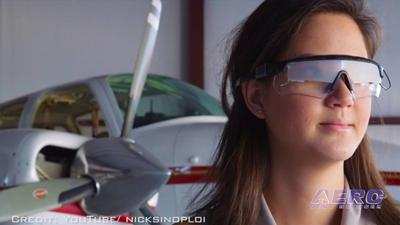Night Hood
ICARUS Devices, a Wisconsin-based start-up founded by Nick Sinopoli in the wake of a friend’s aviation-related death, announced on 19 April 2023 that it has been awarded a contract to supply its Instrument Conditions Awareness Recognition and Understanding System (ICARUS) smart View-Limiting Device (VLD) to AAR Worldwide Aviation Support Services (WASS)—a privately-owned, Illinois-based provider of aviation fabrication and repair services—and the U.S. Department of State Air Wing.

The contract includes both standard ICARUS Devices and the Night Vision Goggle (NVG) compatible iteration of the ICARUS visor.
AAR-WASS operates a fleet of diverse, rotary and fixed-wing aircraft skillfully flown by a cadre of professionals engaged in providing global, world-class, expeditionary and conventional aviation solutions to the U.S. Department of State Air Wing.
AAR-WASS deputy chief of standards Blaine Tirendi stated: “We are excited to be adding the ICARUS device to our training regimen. Our worldwide team of pilots will no doubt benefit from the realism that ICARUS provides in emulating marginal VFR and IFR conditions. ICARUS will be integrated in everything from routine progression and training, to evaluations, and will be an integral tool used in our new IIMC training program of instruction.”
View Limiting Devices (VLD) such as the ICARUS smart visor are utilized by civilian Certified Flight Instructors/Instrument (CFIIs) and military Instructor Pilots (IPs) to train student pilots in the high art of competently controlling and navigating aircraft solely by reference to flight-instruments under Instrument Meteorological Conditions (IMC)—such as those occasioned by clouds, fog, haze, heavy rain, blowing snow, and dust.
By virtue of its ability to rapidly change opacity, the ICARUS smart VLD allows flight-instructors to alter student pilots’ in-flight visibility, thereby creating dynamic, scenario-based flight-training environments. The ICARUS device's polymer dispersed liquid-crystal visor cutout is controlled by an App or manually via a power control unit manipulated by the CFII/IP. The device can be tailored to any airframe and weighs a scant 2.5-ounces.
Developed in 2014 and patented in 2016, the ICARUS device is currently utilized by numerous civilian flight-schools, law-enforcement agencies, and Part 135 air-taxi and air-ambulance operators. Whether applied to primary IFR training or professional pilots’ recurrent training events, the ICARUS device is eminently effective and conducive to use in aircraft as disparate as Cessna’s 172 Skyhawk, Gulfstream’s G-650, and the U.S. Army’s LUH-72A Lakota.
The ICARUS device significantly improves three key aspects of instrument training. During Inadvertent Instrument Meteorological Conditions (IIMC) training events, ICARUS simulates rapid reductions in pilot visibility, thereby evoking the startle effect and forcing emergency transitions to instrument flight. Secondly, the ICARUS device enhances IFR proficiency by mimicking real world weather conditions during practice IFR approaches. Finally, by replicating marginal visibility conditions, the ICARUS device allows CFIIs/IPs to assess students’ IFR decision-making skills—a salient component of Pilot-in-Command (PIC) check rides.

The ICARUS Night Vision Goggle (NVG) compatible visor attaches to the ends of standard, binocular NVG tubes and weighs just a 1/10th of a pound. The NVG compatible model utilizes the same power control unit and App as the standard ICARUS Device.
At a per-unit cost of $1,250, the ICARUS device is within the fiscal purview of even small flight-schools. What’s more, the system’s superiority to conventional IFR training hoods—dove-gray horrors despised in equal measure by the greenest student-pilots and saltiest ATPs —is apt to spark interest and enthusiasm amongst both instrument students and CFIIs, in so doing, driving up flying hours, training quality, check-ride performance, and bottom-line.
 Airborne 07.22.25: MOSAIC Released!, Able Flight, SUN n FUN 26
Airborne 07.22.25: MOSAIC Released!, Able Flight, SUN n FUN 26 Airborne 07.23.25: VoltAero, Bud Anderson Remembered, WomenVenture, Beta
Airborne 07.23.25: VoltAero, Bud Anderson Remembered, WomenVenture, Beta ANN's Daily Aero-Term (07.26.25): Downburst
ANN's Daily Aero-Term (07.26.25): Downburst ANN's Daily Aero-Linx (07.26.25)
ANN's Daily Aero-Linx (07.26.25) Airborne 07.24.25: Spirit SE-1!, H55 eFlyer, King Schools
Airborne 07.24.25: Spirit SE-1!, H55 eFlyer, King Schools




